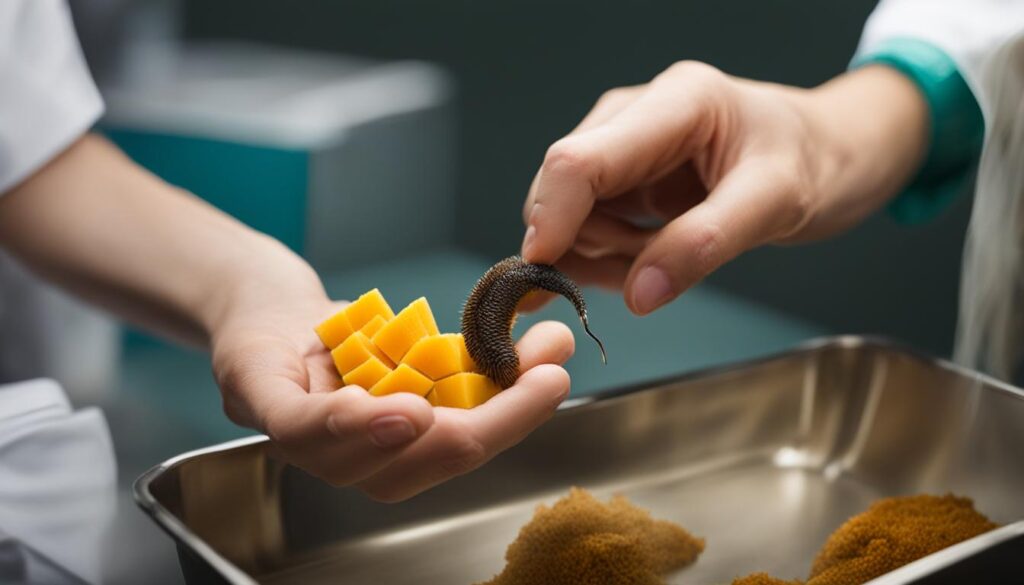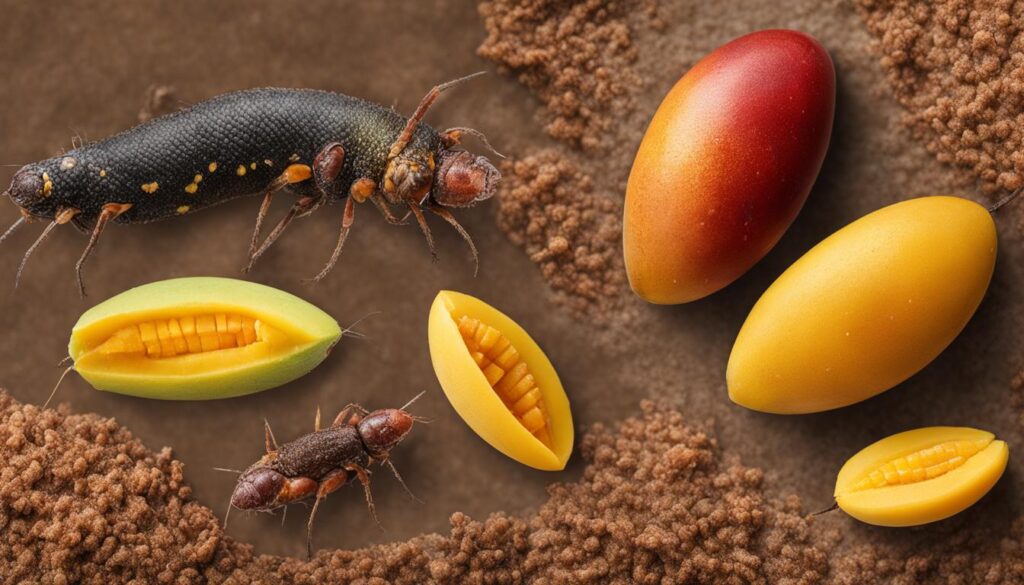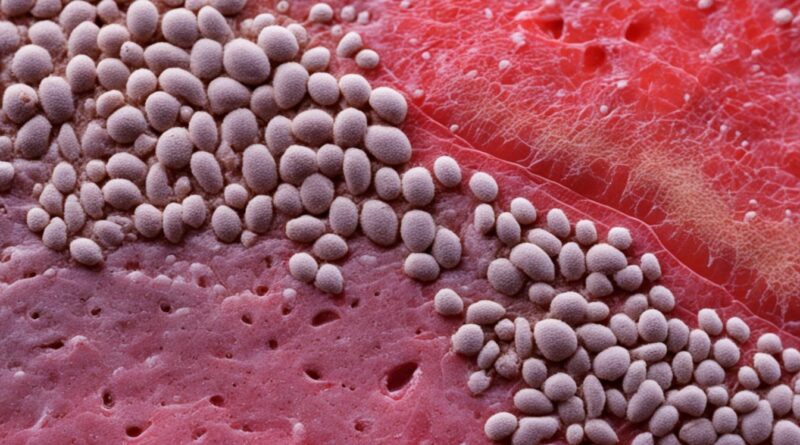Understanding How Dogs Get Mango Worms
Mango worms are a common parasitic infestation that affects dogs, especially in sub-Saharan Africa. These parasites are the larvae of a specific type of fly that lay their eggs on hosts, including dogs. Understanding how dogs become infested with mango worms is crucial in preventing and treating this condition.
Key Takeaways:
- Dogs can get mango worms through direct contact with contaminated soil or vegetation.
- Poor hygiene practices and inadequate living conditions can increase the risk of infestation.
- Veterinary assistance is essential for diagnosing and treating mango worm infestation in dogs.
- Regular grooming practices, cleanliness, and preventive measures help prevent mango worm infestation.
- Mango worms go through a life cycle from eggs to larvae to adult flies.
Signs of Mango Worm Infection in Dogs
Recognizing the signs of mango worm infestation in dogs is crucial for prompt treatment and prevention of complications. The symptoms of mango worm infestation can vary, but there are several common signs to watch out for:
- Skin Lesions: Visible skin lesions characterized by raised bumps or lumps are a telltale sign of mango worm infection. These lesions may appear anywhere on the dog’s body, particularly around areas with thin skin, such as the muzzle, ears, or paws.
- Itching and Scratching: Dogs with mango worm infestation often experience intense itching and may scratch or chew at the affected areas. This behavior is an instinctive response to the discomfort caused by the presence of the worms.
- Swelling and Pain: Infected areas may become swollen and painful, especially as the mango worms burrow deeper into the skin. Dogs may exhibit signs of discomfort or exhibit a reluctance to let anyone touch or handle the affected areas.
- Development of Secondary Infections: Mango worm infestation can lead to secondary infections, as the skin lesions provide an entry point for bacteria. Signs of secondary infections may include redness, pus, foul odor, and increased pain or discomfort.
If you notice any of these signs in your dog, it is crucial to seek veterinary assistance promptly. Timely treatment can help prevent further complications and discomfort.
Veterinary Treatment for Mango Worms in Dogs
Veterinary assistance is crucial in diagnosing and treating mango worm infestation in dogs. When a dog shows signs of mango worm infestation, it is important to consult a veterinarian for a thorough examination and accurate diagnosis. The veterinarian will conduct skin scrapings and other tests to confirm the presence of mango worms.
Once the diagnosis is confirmed, the veterinarian will recommend treatment options based on the severity of the infestation. These options may include:
- Manual Extraction: In less severe cases, the veterinarian may manually remove the mango worms from the dog’s skin. This procedure requires skill and precision to extract all the worms.
- Medication: The veterinarian may prescribe medication to help alleviate secondary infections or discomfort caused by the mango worm infestation.
- Surgical Removal: In more severe cases, surgical removal of the mango worms may be necessary. This procedure is performed under anesthesia and involves removing the worms and treating any resulting wounds.
Post-treatment care is vital for the successful treatment of mango worms in dogs. The veterinarian will provide instructions on wound care, medication administration, and follow-up visits. It is important to closely follow these instructions to ensure the dog’s full recovery.
Prevention of Mango Worm Infestation in Dogs
To ensure the health and well-being of your dog, it is crucial to take preventive measures against mango worm infestation. By implementing these preventive strategies, you can greatly reduce the risk of your dog contracting these parasites.
Grooming Practices: Regular grooming plays a vital role in preventing mango worm infestation in dogs. Brushing your dog’s coat helps to detect any signs of infestation early on. Additionally, bathing your dog with a gentle, pet-friendly shampoo can help maintain overall skin health.
Living Area Maintenance: Keeping your dog’s living areas clean and free from debris is essential to prevent the spread of mango worm eggs. Regularly clean and disinfect their bedding and favorite resting spots, and ensure that there is no stagnant water or food waste that may attract flies.
Avoid High-Risk Areas: Dense vegetation, particularly in warm and humid environments, serves as a breeding ground for mango flies. Avoid taking your dog to areas with dense vegetation, such as grassy fields or overgrown gardens, where the risk of mango worm infestation is higher.
Preventive Products: Consult with your veterinarian to identify suitable preventive products. This may include spot-on treatments, which are applied directly to your dog’s skin, or GPS dog collars that help monitor and prevent them from entering high-risk areas. These products are designed to repel flies and reduce the risk of infestation.
Education and Veterinary Guidance: Staying updated and educated about mango worms is crucial for effective prevention. Regularly consult with your veterinarian, who can provide valuable insights on preventive measures specific to your dog’s breed, lifestyle, and geographic location.
Prevention of Mango Worm Infestation Checklist:
- Regularly brush and bathe your dog to detect any signs of infestation.
- Maintain cleanliness in your dog’s living areas and remove any potential breeding grounds.
- Avoid areas with dense vegetation, particularly in warm and humid environments.
- Consult with your veterinarian for suitable preventive products, such as spot-on treatments or GPS dog collars.
- Stay updated and educated about mango worms by seeking veterinary guidance.
Treatment Options for Mango Worms in Dogs
When it comes to treating mango worm infestation in dogs, there are several effective options to consider. These treatment options aim to remove mango worms from dogs and alleviate discomfort caused by the infestation. It is crucial to consult with a veterinarian for a proper diagnosis and treatment plan tailored to the specific condition of the dog.
Here are some common treatment options for mango worms in dogs:
- Manual extraction by a trained professional: In less severe cases, a veterinarian or trained professional can manually remove the mango worms from the dog’s skin. This process involves careful extraction of the worms using specialized tools to ensure their complete removal.
- Surgical removal: In more severe cases, surgical intervention may be necessary to remove mango worms from deep skin layers or inaccessible areas. A veterinarian will assess the extent of the infestation and determine if surgical removal is the best course of action.
- Medication for secondary infections or discomfort: Mango worm infestations can lead to secondary bacterial infections or cause discomfort for the affected dog. Veterinarians may prescribe antibiotics or other medications to treat these secondary infections and alleviate discomfort during the healing process.
- Proper wound management: After mango worm removal, proper wound management is essential to promote healing and prevent infections. This may involve cleaning the affected areas, applying topical ointments or dressings, and monitoring the wound for any signs of complications.

Removing mango worms from dogs is a delicate process that requires professional expertise. A veterinarian will determine the most suitable treatment option based on the severity of the infestation and the dog’s overall health. Following the recommended treatment plan and providing appropriate aftercare are crucial for the successful management of mango worm infestation in dogs.
Mango Worm Life Cycle in Dogs
Mango worms undergo a fascinating life cycle that involves several stages of development. Understanding this life cycle is crucial for effectively managing mango worm infestation in dogs.
The life cycle begins when the female mango fly lays her eggs on the ground or on fabric in areas frequented by dogs. These eggs are tiny and are often deposited in clusters. When the conditions are favorable, such as warm temperatures and humidity, the eggs hatch, and the larvae emerge.

As larvae, known as mango worms, they actively search for a suitable host to infest. Dogs, being warm-blooded animals, are a prime target for these parasites. The mango worms burrow into the dog’s skin, typically through open wounds or hair follicles.
Once inside the dog’s skin, the larvae feed on the host’s tissues for approximately two to three weeks. During this feeding phase, the larvae continue to grow and develop. They consume nutrients from the host, causing discomfort and potentially leading to secondary infections.
When the mango worms have completed their growth phase, they prepare to leave the dog’s body. At this stage, the worms create an exit hole in the skin, forming a distinct breathing pore called a “screwworm.” They then force themselves out of the host’s skin, often causing pain and irritation in the process.
Once outside, the mango worms drop to the ground and undergo metamorphosis, transforming into pupae. They develop within the pupae for a period of time before emerging as adult flies. These flies are fully capable of reproducing and starting the life cycle anew, perpetuating the infestation cycle.
Mango Worm Life Cycle Summary:
| Stage | Description |
|---|---|
| Egg stage | Female mango flies lay eggs on the ground or fabric, typically in areas accessible to dogs. |
| Larval stage (Mango Worms) | The hatched larvae actively search for a host and burrow into the dog’s skin, feeding on the host’s tissues for two to three weeks. |
| Exit stage | The fully developed mango worms create an exit hole in the host’s skin and force themselves out. |
| Pupal stage | The worms drop to the ground and develop within pupae, transforming into adult flies. |
| Adult stage | The adult flies emerge, ready to reproduce and continue the life cycle. |
By understanding the mango worm life cycle, dog owners and veterinarians can implement effective prevention and treatment strategies to protect dogs from infestation and promote their overall well-being.
Natural Remedies for Mango Worm Infestation in Dogs
While consulting with a veterinarian is essential for proper treatment of mango worm infestation, there are some natural remedies that may help alleviate discomfort or promote healing in dogs affected by this condition.
- Applying natural oils: Certain natural oils, such as neem oil or tea tree oil, have antiparasitic properties that can help reduce the infestation of mango worms. Dilute the oil with a carrier oil, like coconut oil, and apply it to the affected areas of the dog’s skin. The soothing properties of these oils may help relieve itching and promote the healing process.
- Using soothing herbs: Some herbs, such as aloe vera or chamomile, have anti-inflammatory and wound-healing properties. Prepare a herbal infusion by steeping the herbs in hot water and allowing it to cool. Use a clean cloth to apply the herbal infusion to the affected areas of the dog’s skin, providing relief and promoting healing.
- Promoting hygiene and cleanliness: Keeping the dog and its living area clean is essential for managing mango worm infestation. Regularly bathe the dog with a gentle, hypoallergenic shampoo to remove any eggs or larvae present on the skin. Clean the bedding and surrounding areas to minimize the risk of reinfection.
- Using natural antiparasitic products: There are natural antiparasitic products available that are specifically formulated for dogs. These products often contain ingredients like essential oils or herbal extracts that help repel and kill parasites. Consult with a veterinarian to find a suitable natural antiparasitic product for your dog.
It is important to note that while natural remedies can provide some relief, they should always be used in conjunction with professional veterinary treatment. Mango worm infestation can be a serious condition that requires proper diagnosis and treatment from a qualified veterinarian. Natural remedies can serve as supportive measures to enhance the overall treatment plan and promote the well-being of the affected dog.
| Advantages of Natural Remedies | Considerations |
|---|---|
|
– Natural oils and herbs can provide soothing relief to the affected dog’s skin. – Natural remedies may be less likely to cause adverse reactions or side effects compared to certain medications. – Regular hygiene practices can help prevent reinfestation and promote overall skin health. |
– Natural remedies alone may not be sufficient to eliminate mango worms completely. – Different dogs may respond differently to natural remedies, and individual results may vary. – It is crucial to consult with a veterinarian to ensure the safety and effectiveness of natural remedies. |
Conclusion
Mango worm infestation is a significant concern for dogs in certain regions, particularly sub-Saharan Africa. To effectively manage this problem, it is crucial for dog owners to recognize the signs of infestation, seek veterinary assistance promptly, and follow the recommended treatment plan.
Veterinary treatment for mango worms in dogs typically involves thorough examination and diagnosis by a veterinarian. Treatment options may include manual extraction of the worms, medication for secondary infections or discomfort, and, in severe cases, surgical removal. Regular post-treatment care and follow-up visits are also important for the complete recovery of the dog.
Preventing mango worm infestation in dogs is equally important. By practicing regular grooming, maintaining cleanliness in living areas, avoiding high-risk areas with dense vegetation, and using preventive products recommended by veterinarians, dog owners can significantly reduce the risk of their pets getting infested.
By staying proactive, well-informed, and taking necessary preventive measures, dog owners can safeguard their beloved pets from the parasitic infestation of mango worms.
FAQ
How do dogs get mango worms?
Dogs can get mango worms when they come into contact with the eggs of the mango fly, usually through direct contact with contaminated soil or vegetation.
What are the signs of mango worm infection in dogs?
The signs of mango worm infection in dogs include visible skin lesions, itching and scratching at affected areas, swelling and pain, and the development of secondary infections.
How are mango worms in dogs treated?
Mango worm infestation in dogs is treated through options such as manual extraction, surgical removal for severe cases, medication for secondary infections or discomfort, and proper wound management.
How can mango worm infestation in dogs be prevented?
Mango worm infestation in dogs can be prevented through regular grooming practices, maintaining cleanliness in living areas, avoiding high-risk areas, and using preventive products recommended by veterinarians.
What are the treatment options for mango worms in dogs?
The treatment options for mango worms in dogs include manual extraction, surgical removal, medication for secondary infections or discomfort, and proper wound management.
What is the life cycle of mango worms in dogs?
The life cycle of mango worms in dogs starts with the female mango fly laying eggs on the ground or on fabric. When the eggs hatch, the larvae burrow into the dog’s skin, where they feed for two to three weeks. Once fully mature, the worms burst out of the skin and develop into adult flies.
Are there any natural remedies for mango worm infestation in dogs?
While consulting with a veterinarian is crucial, some natural remedies, such as applying natural oils or soothing herbs, ensuring proper hygiene and cleanliness, and using natural antiparasitic products recommended by veterinarians, may help alleviate discomfort or promote healing.


